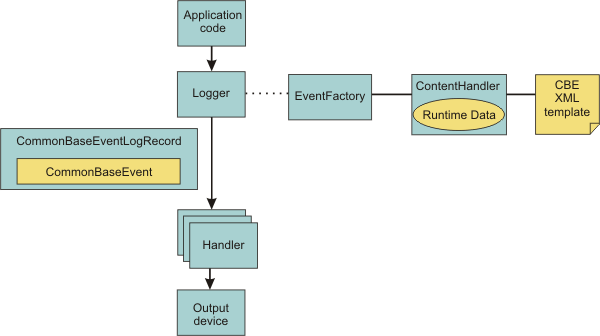java.util.logging -- Java logging programming interface
The java.util.logging.Logger class provides a variety of methods with which data can be logged.
In the WAS, when using basic log and trace mode, the Java logging API (java.util.logging) automatically creates Common Base Events for events that are logged at the WsLevel.DETAIL level or later (including WsLevel.DETAIL, Level.CONFIG, Level.INFO, WsLevel.AUDIT, Level.WARNING, Level.SEVERE, and WsLevel.FATAL). These Common Base Events are created using the event factory that is associated with the logger to which the message is logged. If no event factory is specified, WAS uses a default event factory which automatically fills in WebSphere Application Server-specific information.
The WAS uses a special implementation of the java.util.logging.Logger class that automatically creates Common Base Events for the following methods:
- config
- info
- warning
- severe
- log: All variants except log(LogRecord) when used with the WsLevel.DETAIL
level or more severe levels
- logp: When used with the WsLevel.DETAIL level or more severe levels
- logrb: When used with the WsLevel.DETAIL level or more severe levels
The WebSphere Application Server logger implementation is used only for named loggers for example, loggers that are instantiated with calls, such as Logger.getLogger("com.xyz.SomeLoggerName"). Loggers instantiated with calls to the Logger.getAnonymousLogger and Logger.getLogger, or Logger.global methods do not use the WAS implementation, and do not automatically create Common Base Events for logging requests made to them. Log records that are logged directly with the Logger.log(LogRecord) method are not automatically converted by WebSphere Application Server loggers into Common Base Events.
The following diagram illustrates how application code can log Common Base Events:

The Java logging API processing of named loggers and message-level events proceeds as follows:
- Application code invokes the named logger (WsLevel.DETAIL or later)
with event-specific data.
- The logger creates a Common Base Event using the createCommonBaseEvent
method on the event factory that is associated with the logger.
- The logger creates a Common Base Event using the event factory associated to the logger.
- The logger wraps the common base event in a CommonBaseEventLogRecord
record, and adds event-specific data.
- The logger calls the Common Base Event complete method.
- The Common Base Event invokes the ContentHandler completeEvent
method.
- The content handler adds XML template data to the Common Base
Event (including for example, the component name). Not all content handlers support templates.
- The content handler adds runtime data to the Common Base Event
(including for example, the current thread name).
- The logger passes the CommonBaseEventLogRecord record to the handlers.
- The handlers format data and write to the output device.
Related tasks